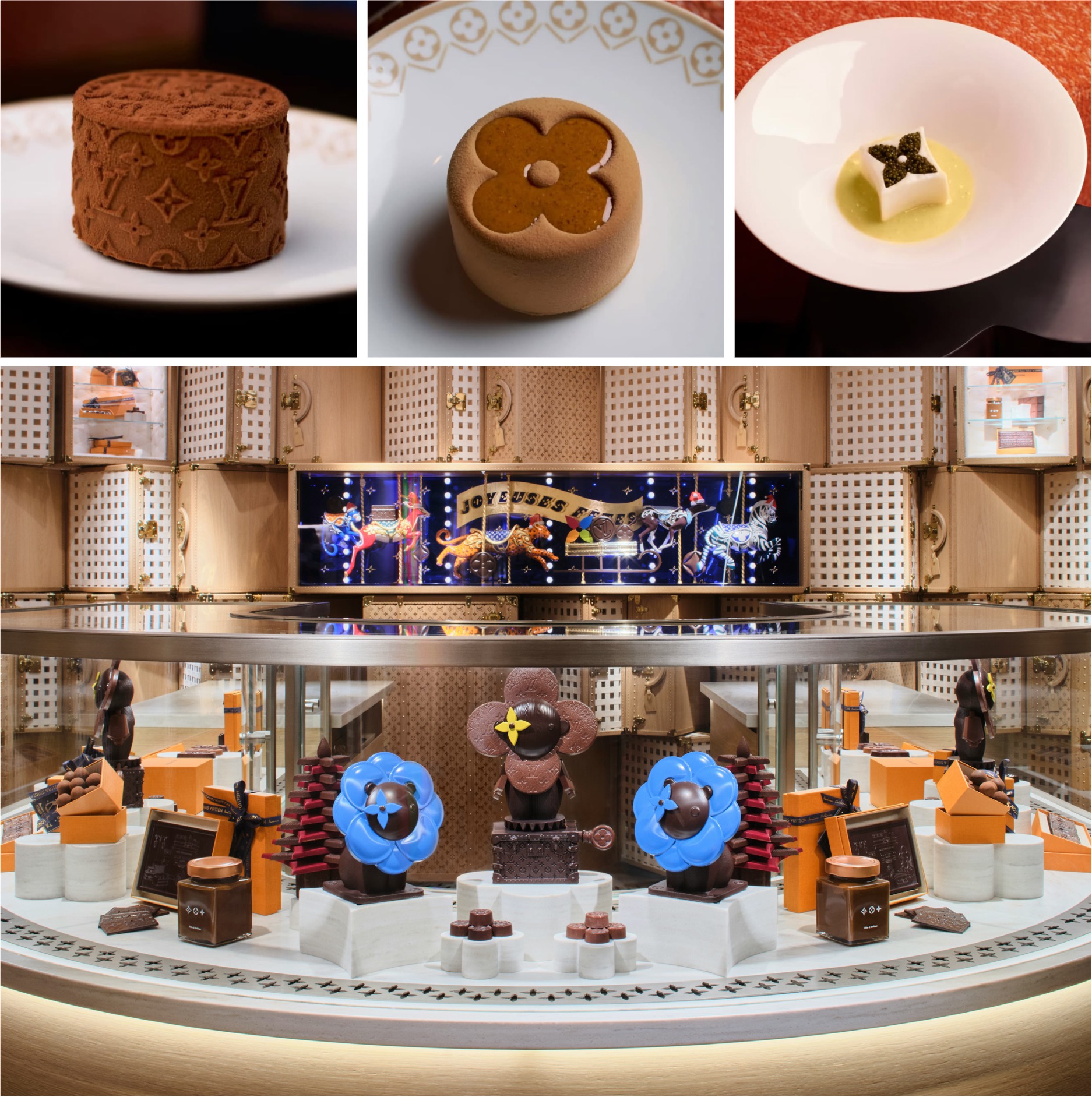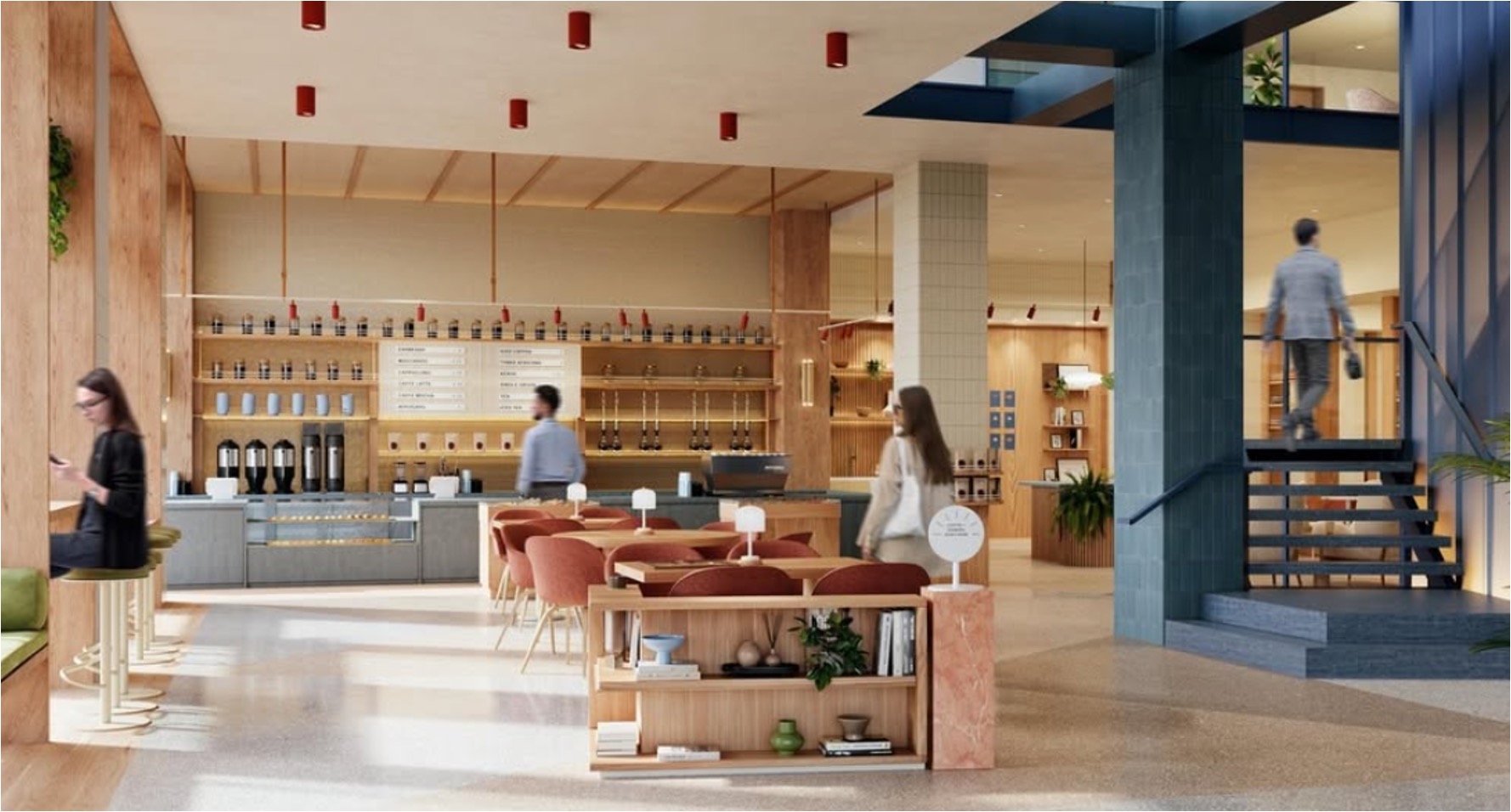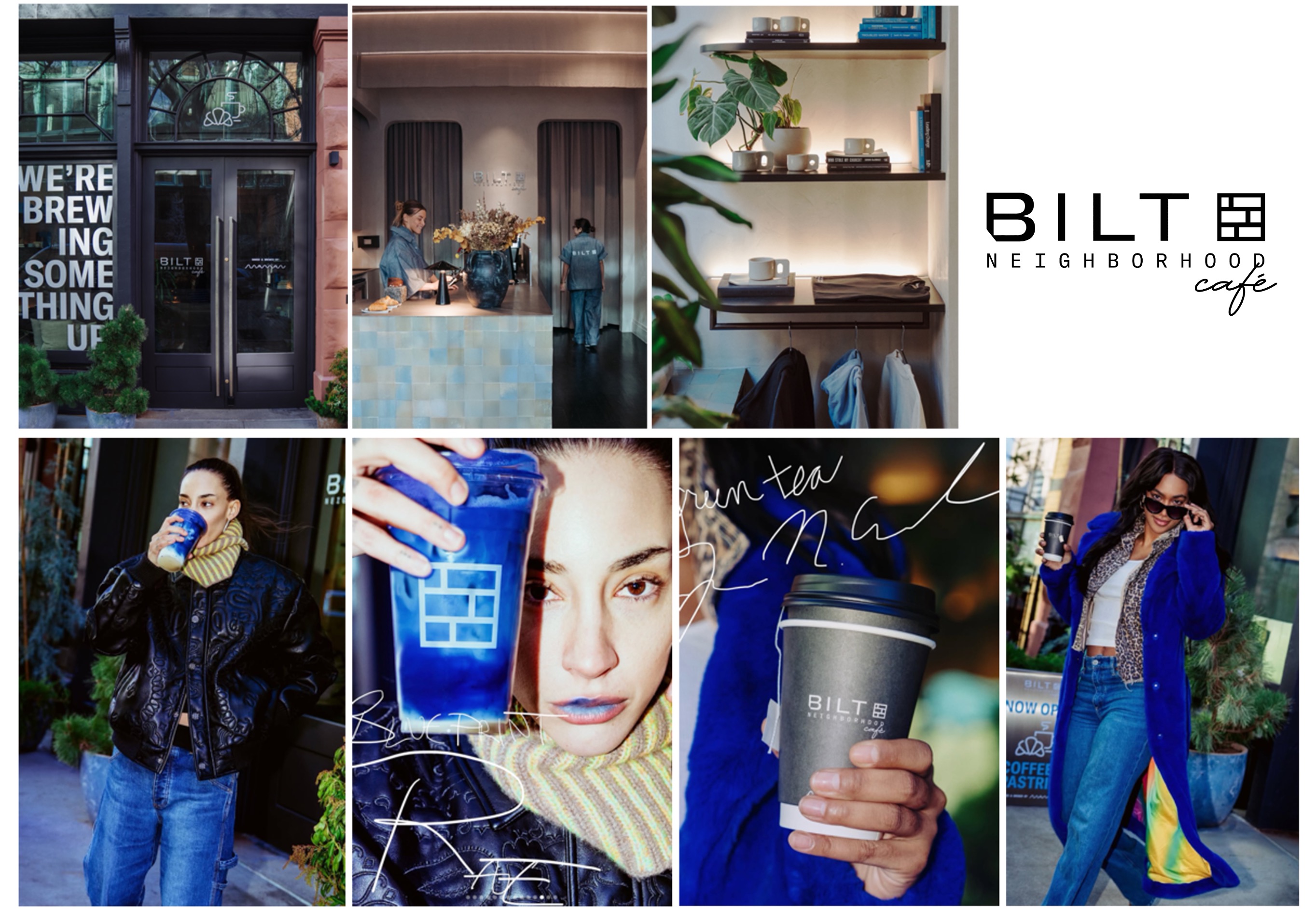

In New York City, brands are redefining consumer engagement through experiential dining. Luxury fashion houses and innovative companies are transforming traditional retail spaces into immersive experiences, blending gastronomy with brand storytelling. Is there strategic merit in curating a brand experience that’s good enough to eat? Let’s explore six standout examples that show us how it’s done.
Le Café Louis Vuitton just off 5th Avenue on 57th Street isn’t just a restaurant—it’s a strategic extension of the brand’s identity, blending retail, culture, and gastronomy, deepening consumer engagement through sensory storytelling.
Get a Taste of The “Bon Voyage” Lifestyle

Design Aesthetics Reinforcing Heritage: Library-style interiors and stacked LV trunks embody Louis Vuitton’s legacy of travel, exclusivity, and craftsmanship. Monogrammed chocolate masterpieces by renowned Japanese artist Takashi Murakami sit alongside French pastries by the celebrated chef Maxime Frédéric, creating a fusion of global luxury and cultural excellence—an environment that epitomizes Louis Vuitton’s world-class vision.
Where Travel Meets Taste: Michelin-starred chefs curate a menu that transforms dining into a brand touchpoint, where dishes mirror the Louis Vuitton lifestyle—globally inspired yet locally sourced, rooted in French elegance, while honing American sensibility, and Mediterranean influences.
Monogrammed to Memory: Monograms are reinforced throughout the dish presentation, whether it’s a waffle, a hamburger, or a gorgeous vehicle for caviar. Signature dishes like Le Croque Louis Paris and Crab Louis Salad reinforce the brand name and identity through taste. By offering a “Louis Vuitton take” on culinary classics, the café leverages cognitive principles like familiarity and trust, strengthening brand loyalty and reinforcing its status as a cultural institution.
Ralph’s Coffee and The Polo Bar are more than dining destinations—they are curated extensions of the Ralph Lauren lifestyle, designed for those who aspire to timeless elegance, heritage, and exclusivity. Every detail reinforces the classic Americana aesthetic, immersing patrons in an experience that signals refinement, wealth, and tradition.
You Too Can Taste the American Dream of Quiet Luxury

Old-Money Ambiance: The interiors evoke the world of American aristocracy, where legacy and tradition define luxury. Rich mahogany paneling, plaid upholstery, vintage brass fixtures, and equestrian artwork create a setting reminiscent of private East Coast clubs and country estates. Patrons aren’t just dining; they are stepping into a world that embodies old-money prestige—where wealth is subdued, not flaunted.
Dressing the Part of American Elegance: From the tailored blazers and crisp oxford shirts worn by staff to the equestrian-inspired leather accents, every detail of the uniform is an extension of Ralph Lauren’s sartorial identity. It’s not just service—it’s a performance of refined Americana, reinforcing the brand’s legacy of understated luxury and classic style.
A Menu That Feels Like Tradition: The food itself reflects classic American heritage, with signature dishes like the Ralph Lauren Burger, prime rib, and hand-shaken martinis served in refined yet familiar presentations. These offerings speak to those who value tradition over trends, aligning with the Ralph Lauren ethos of timeless quality and prestige.
Capital One Cafés resemble coffee shops more than bank branches, offering a relaxed environment where customers can enjoy beverages while discussing financial needs with ambassadors. By meeting customers on their terms, Capital One enhances brand perception, positioning itself as a customer-centric and innovative financial institution. The cafés provide human connections in a digital world, fostering trust and loyalty while simultaneously embodying the brand’s innovative spirit and dedication to enhancing customer experiences.
Banking… But First, Coffee

Relaxed Environmental Design: The cafés feature modern, comfortable furnishings that reflect Capital One’s approachable and customer-friendly brand image.
Service Model Over Coffee: Ambassadors, rather than tellers, offer personalized assistance without the pressure of sales quotas, aligning with the brand’s commitment to customer-centric services.
Bilt, known for its innovative rewards program that allows members to earn points on rent payments, has expanded its brand presence by opening the Bilt Neighborhood Café in NoHo, New York City. This café at 31 Bond Street is more than just a coffee shop; it is a strategic extension of Bilt’s commitment to community-building and brand engagement.
Compared to Capital One Café, which focuses on financial discussions in a relaxed coffeehouse setting, Bilt’s café is a more social-driven space. While both integrate brand values into their environments, Capital One emphasizes approachable banking solutions, whereas Bilt strengthens loyalty through hospitality and a sense of exclusivity.
Sipping on Status at Your Neighborhood Spot

Designed for Street Cred: The café’s modern, minimalist design reflects Bilt’s sleek branding, with stainless steel accents. In addition, Bilt’s socials highlight “the Regulars” focusing on their streetwear fashion.
A Familiar Culinary Partnership: The café collaborates with beloved NYC bakery Maman, offering premium coffee and pastries. A collaboration with a local favorite helps position the brand as an insider while also capitalizing on Maman’s brand recognition and reputation.
Located within their Fifth Avenue flagship store, Tiffany & Co.’s Blue Box Café immerses guests in the brand’s world-famous blue ambiance. The café not only reinforces brand recognition through visual and thematic consistency but also allows patrons to become part of the brand’s storied legacy.
Have Breakfast at Tiffany’s

Inside the Box: The café’s design is a three-dimensional representation of Tiffany’s iconic blue box, with every element—from the walls to the tableware—featuring the signature hue.
From Diamonds to Deserts: Menu items are elegantly presented, often incorporating thematic elements that reflect Tiffany’s jewelry designs and luxury image. A delicate robin’s egg blue éclair, its glossy glaze shimmering like the signature Tiffany box, arrives on a fine china plate edged in platinum. The café’s signature cake, adorned with sugar pearls and edible gold leaf, is a visual echo of the brand’s legendary diamond settings.
Armani Ristorante offers a dining experience that mirrors the brand’s minimalist elegance and commitment to excellence. Located on Fifth Avenue, the restaurant embodies Giorgio Armani’s design philosophy through its sleek interiors and refined Italian cuisine. Armani Ristorante translates the brand’s fashion principles into a culinary context, providing a holistic brand experience. This seamless integration of design, service, and cuisine allows diners to engage with the brand on a deeper level, beyond apparel.
How Armani Translates Runway Refinement to the Plate

A Space of Understated Elegance: The restaurant features clean lines, luxurious materials, and a monochromatic palette, reflecting Armani’s fashion aesthetic.
Where Minimalism Meets Michelin: The menu focuses on high-quality ingredients and sophisticated presentations, aligning with the brand’s dedication to craftsmanship.
Holistic Design Integration: Each establishment meticulously incorporates brand aesthetics into its interiors, creating immersive environments where every visual element is a touchpoint reinforcing brand identity.
Product and Service Alignment: Menu offerings and service styles are thoughtfully crafted to echo brand values and codes, ensuring consistency across all customer interactions.
Consistent Brand Messaging: Ensure that every element of the dining experience—from décor to menu design—aligns with the brand’s core values and visual identity.
Sensory Branding: Utilize all five senses to create a memorable experience. The taste of the food, the sound of the music, the feel of the furnishings—all should reflect the brand.
These establishments demonstrate that when brand codes are thoughtfully intertwined with dining experiences, they not only enhance customer satisfaction but also foster brand loyalty and advocacy. As the lines between retail, hospitality, and branding continue to blur, experiential dining emerges as a powerful strategy for brands to connect with consumers on a deeper, more emotional level.
Sarah Bourek
Labbrand New York
A Labbrand Group Company © 2005-2024 Labbrand All rights reserved
沪ICP备17001253号-3* Will be used in accordance with our Privacy Policy
To improve your experience, we use cookies to provide social media features, offer you content that targets your particular interests, and analyse the performance of our advertising campaigns. By clicking on “Accept” you consent to all cookies. You also have the option to click “Reject” to limit the use of certain types of cookies. Please be aware that rejecting cookies may affect your website browsing experience and limit the use of some personalised features.